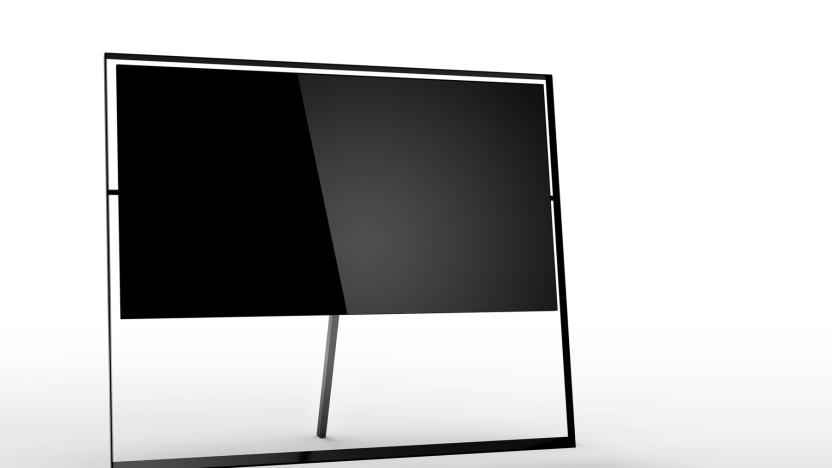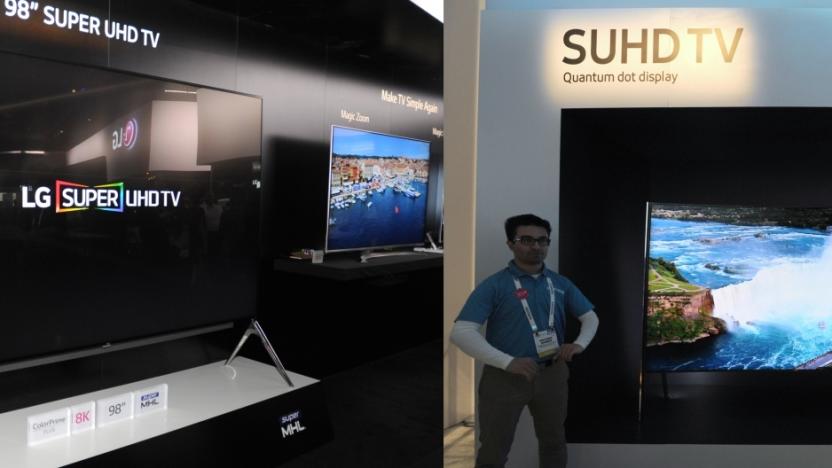SuperHi-vision
Latest

The first 8K satellite TV broadcasts launched today in Japan
As scheduled, at 10 AM local time on December 1st Japanese TV networks began publicly broadcasting 4K and 8K channels via satellite. Even after a couple of years of testing, NHK is currently the only one pushing content at 8K with 22.2 channel sound. The first movie listed in its TV guide is 2001: A Space Odyssey, and the BBC reports that Warner Bros. rescanned the film's original 70mm negatives specifically for this broadcast.

Sharp's 8K satellite receiver is ready for broadcasts to start in Japan
As we learned during IFA last month, the 8K hype train is here whether we're ready or not. In Japan everything is timed to coincide with the 2020 Summer Olympic Games in Tokyo, and as such broadcaster NHK is planning to kick off hybrid 4K/8K broadcasts beginning December 1st. Assuming you have access to an 8K TV or projector, you'll need a box to actually catch and process the Super Hi-Vision video signal, and fortunately Sharp has one ready to connect to its 8K TV that has been on sale since 2017.

Samsung's 8K TV uses AI that 'learns' to upscale low-res video
In 2013 Samsung introduced a $40,000 85-inch 4K TV with an easel-like design, before showing off an 8K demo unit in 2014. Now at CES 2018 Samsung is showing off this 8K-resolution Q9S that continues the same design strategy, just with more pixels and AI inside. Pit that against LG's 88-inch 8K OLED, and it looks like 2016's LG-versus-Samsung battle is ready to resume. We don't have details like a price or release date for the Q9S, but the 85-inch monster features a "proprietary algorithm" to upscale lower-res video for its Super Hi-Vision screen. The artificial intelligence comes in with its ability to "learn from itself" to improve over time -- which could be interesting if it works well, and could also lead to some incredible self-created artifacts if something goes wrong.

Sharp is ready to sell 8K consumer TVs now that we all have 4K
While other electronics companies are just getting to consumer 4K screens, Sharp is once again focusing on the next resolution milestone. Today, Sharp announced its 8K AQUOS televisions will be coming to Japan and China in December, with releases in Taiwan and Europe planned for early 2018.

The first 8K satellite TV broadcasts are live in Japan
Just as we were getting used to Ultra HD 4K, Japan's NHK has kicked off its Super Hi-Vision broadcast tests, sending out 4K and 8K video via satellite. Unfortunately, there's no way to watch the super high res feeds and 22.2 channel sound at home -- even with a $130,000 8K TV -- but interested Japanese residents can check out tests of the feeds at several public locations in Tokyo and Osaka. NHK is using the Rio Olympics as a testbed for technology that it hopes to roll out first in 2018, and have ready for the public time for the 2020 Olympics in Japan.

NBC will air the 2016 Rio Olympics in 4K, HDR and Atmos
NBC has announced that it will make content from this year's Olympic Games available to carriers in 4K and HDR, however there's one little catch. In a setup that will seem familiar for early HDTV adopters who still can't get Sony's "we brought chips... and salsa!" ad out of their heads 12 years later*, 4K UHD footage of the Opening and Closing Ceremonies, swimming, track and field, basketball, the men's soccer final, and judo is coming home on 24 hour tape delay. NBC will provide a downconverted version of the 8K feed Olympic Broadcasting Services and Japan's NHK are experimenting with, to 4K, and present it in HDR with Dolby Atmos surround sound audio. According to NBC Sports president Gary Zenkel, "The Olympics have been a consistent driver of technological advancements, and Rio will be no different."

8K Attack: LG's and Samsung's super high-res TVs are here
We're barely emotionally adjusted to the existence of 4K, but already tech companies are looking to the next big thing. Sharp put its $130,000 8K TV on sale last year while this week both LG and Samsung showed off "real" 98-inch Super Hi-Vision screens. LG said its 8K television would go on sale in the second half of this year, but it didn't specify a price. Samsung doesn't have a release date or price for its TV either, but the bigger question of what you can even connect to these behemoths also has no answer. The last time I saw an 8K broadcast, it needed an Internet2 connection and a decoder the size of a doghouse just to work, so it's probably still a few years away from being feasible. Still, if these hit the market, maybe they can take a hint from Dish's Hopper 3 and watch four 4K videos at once. [Photos by Will Lipman]

These 8K displays may end up on your next tablet
Most of us have barely touched 4K content, but the keen folks in Japan are already showing off some 8K displays, and we're not just talking about those of conventional TV sizes. At CEATEC, NHK brought along three upcoming 8K panels that may end up on future tablets, laptops and monitors. These include JDI's 17.3-inch LCD that was just announced last week, as well as Ortus' insanely sharp 9.6-inch LCD (that's a whopping 915 dpi!) from May, and Sharp/SEL's 13.3-inch OLED display. Even though the OLED panel was unveiled back in June last year, it's still by far the best 8K display out of the three; it's as if you're looking into another world, thanks to the combination of high contrast, strong vibrancy plus insanely sharp resolution. Alas, there's no launch date for any of these just yet, but a spokesperson from NHK hopes to see these come out before the Tokyo 2020 Olympic Games, which will be broadcast in 8K.

The first 8K TV will go on sale soon for over $130,000
Sharp has demonstrated Super Hi-Vision 8K displays before (as seen above during CES 2015), but today in Japan it announced an 85-inch version is going on sale October 30th. Dubbed the LV-85001, it's a monitor (it has a tuner so you could call it a TV, but that can't actually receive 8K video) for professional use only, mostly since there aren't really any broadcasts or content to watch in 8K. Coming in at 16 times the resolution of 1080p screens, the 7,680 x 4,320 pixel LCD panel uses Sharp's IGZO technology. To actually watch any 8K video, you'll need to plug into all four of its HDMI inputs at once just to have enough bandwidth. If you're interested (and why wouldn't you be, even though there's almost nothing to watch), just contact Sharp's business-to-business sales unit, and bring along a check for 16,000,000 yen, or about $133,034 US.

LG's got an 8K television and food looks delicious on it
As per usual, South Korean electronics giant LG is here at IFA in Berlin, Germany. Less usual? The company showing up with a 98-inch 8K (aka Super Hi-Vision) television. LG's saying it's "16 times full HD resolution," and while we didn't sit and count every pixel, the food porn being shown off looked mighty tasty. No pricing or availability was given, but any kind of commercial release is probably pretty far off. The real reason it's here, however, is simply to showcase that LG can create the gorgeous, ultra high-res screen -- just like Sharp did with its massive 8K display a few years ago. And hey, did we mention that the food looked really pretty? Explore its depths in the gallery below. Update: As sweet as this TV is, it's using the older LCD technology, not OLED.

NHK and Mitsubishi develop the first H.265 encoder for 8K video
NHK's 8K Super Hi-Vision is an extremely bandwidth-heavy format -- so much so that earlier tests used gigabit-class internet links rather than traditional TV broadcasting methods. Thankfully, both the broadcaster and Mitsubishi have developed an encoder that could keep data rates down to Earth. The unassuming metal box (above) is the first to squeeze 8K video into the extra-dense H.265 (HEVC) format, cutting the bandwidth usage in half versus H.264. Its parallel processing is quick enough to encode video in real time, too, which should please NHK and other networks producing live TV. We'll still need faster-than-usual connections (and gigantic TVs) to make 8K an everyday reality, but that goal should now be more realistic.

JVC will launch its first (sort of) 8K projector later this month in Japan, for $261,000
JVC showed off a prototype 8K Super Hi-Vision projector in 2008 at CEATEC, and now it's ready to ship a real product later this month, dubbed the DLA-VS4800. JVC's e-Shift pixel technology is at play here, which we first saw in consumer products with the '4K' projectors it shipped in 2011, and updated in last year's models. Basically the D-ILA display panel inside the device is half the resolution (in this one, 4,096 x 2,400) but projects two images alternated at 120Hz, one shifted slightly diagonally. This creates the impression of a higher res display, without actually upping the pixel count. Based on our demos of the tech at CEDIA for the last two years, the effect is very convincing, however with AV Watch's presumed price tag of 25 million yen ($261k US -- and that's without the 4 available lenses, which have no price), we might want a few more real pixels, if such a product were available for purchase. Still, if you want the first 8K display device on the block, this is your only choice, unless you can convince Sharp to part with one of its sweet 8K Super Hi-Vision LCD prototypes (we've asked, we've begged, we've planned Ocean's 11-style heists -- it's not possible.) The other issue is that you'll still need some content to view, and with the roadmap currently putting test broadcasts in 2016, leaving this one to the museums and planetariums it's intended for may be the best course of action.

NHK demonstrates 8K 3D digital binoculars: 16x 'lossless' zoom at 1080p (hands-on)
Alongside its Super Hi-Vision TV demonstrations, Japan's national broadcaster had some 3D goggles also taking advantage of that 8K resolution. With 16 times the pixels of typical 1080p content, these prototype binoculars provide the same multiple of zoom from an 8K feed -- that is 16x zoom without losing any of original data. We got to grips with a the master model here at CEATEC, and were able to pan up and down, as well as manipulate a lever to close in on views of both Mount Fuji and Tokyo's very recent Skytree tower. NHK mentions that it could see the devices being used to show off other sightseeing spots in the future, but we don't expect home installations any time soon.

Panasonic's 145-inch 8K PDP eyes-on (video)
Tucked away into a dark corner of Panasonic's booth is the clear highlight of the outfit's IFA 2012 showcase: a 145-inch 8K plasma display panel. Developed in partnership with Japan's NHK, the prototype is merely a proof of concept for the broadcaster's planned 2020 launch of Super Hi Vision TV. In person, the flat screen is truly awe-inspiring, offering such richness of detail that even up-close we weren't able to discern any pixels, while colors appeared balanced and natural. Overall, the image quality -- 16 times that of regular full HD -- nearly apes the real-world images it replicates. Unfortunately, you'll have to wait sometime before this tech trickles down to the mass market level. In the meantime, content yourself with a brief video demo after the break. Follow all of our IFA 2012 coverage by heading to our event hub!

ITU approves NHK's Super Hi-Vision as 8K standard, sets the UHDTV ball rolling very slowly
We'd heard that the International Telecommunication Union was close to approving Super Hi-Vision as an Ultra High Definition TV standard, and the UN agency hasn't waited long to confirm the rumors. The recommendation to use NHK's 7,680 x 4,320 format has gone unopposed and should define the parameters for incredibly detailed 8K video worldwide. This shouldn't lead anyone to return that 4K TV just yet -- once again, it's important to remember that NHK still won't start any kind of wider testing until 2020. That's also assuming that the first 8K sets are down to Earth instead of the incredibly expensive 145-inch variety.

Nikkei: ITU near recommending NHK's Super Hi-Vision as official TV standard
We've seen NHK preparing its Super Hi-Vision 8K video since time immemorial. Wouldn't it be nice if the TV broadcast technology was more than just a perpetual research project? If sources for Japan's Nikkei aren't dreaming, the International Telecommunication Union is now "likely" to declare the format an official standard for broadcasters and TV makers. Should it go ahead, the UN telecom body would ask the world to rely on Super Hi-Vision as an eventual successor to HDTV and reduce the balkanization of TV standards that we've seen in the past. Neither the ITU nor NHK is known to have commented on the claim so far, but NHK isn't exactly in a rush to get a seal of approval from anyone -- widescale test broadcasts aren't coming until 2020, and production TVs themselves are only just entering a 4K universe.

BBC shows off 33-megapixel Super Hi-Vision Olympic footage, we ask: why?
The first live Super Hi-Vision broadcast for public consumption was of the Olympic opening ceremony in London last week. We didn't get to see that premiere, or the second or third screenings either -- but the fourth? Oh yes. We grabbed a seat right up front of a small theater inside BBC Broadcasting House, watched a live 33-megapixel feed from the Aquatics Center and absorbed some very fond memories in the process. At the same time, a question hung over the footage like a watermark: why bother? The world is barely getting to grips with the notion of 4K, which already solves pixelation at regular viewing distances, so why did the BBC and Japanese broadcaster NHK go to the expense of sending a dedicated SHV video truck, a SHV audio truck rigged for 22.2 channel sound, and the world's only three 8K Ultra HDTV cameras to London? Fortunately, we caught up with someone in charge who was able to respond to that question. Read on for what they said, plus a slightly fuller sense of what the footage was like to watch.

UK 2012 Olympics Super Hi-Vision tickets are available, grab a seat for some Ultra HDTV
If you're a UK resident, missed out a ticket to the London 2012 Olympics and find the extensive home and mobile coverage to be lacking in pixels have no fear -- free tickets are available for Super Hi-Vision screenings at three locations. While certain days and times are already fully booked, you can still get one of the first public glimpses of NHK's 8K Ultra HDTV technology at the BBC Radio Theatre, BBC Scotland (Glasgow) and the National Media Museum in Bradford (other viewing locations are in Japan and Washington D.C.) Before the games get started, the Radio Theater is screening a London Prepares promo from July 23rd to the 28th. During the games (July 28th - August 12th) all will have highlights of the previous day's action from the Aquatic Centre, Olympic Stadium, Velodrome, and Basketball Arena plus clips of the Opening Ceremony. The lone live feed is scheduled for Sunday July 29th, from the Aquatics Centre. Sure, you could be paying a fortune for scalped passes to be in the house when Usain Bolt, Ryan Lochte or Michael Phelps are doing their thing, or you could be enjoying 33MP video and 22.2 channel surround sound in one of the custom setups TechRadar previewed in March. Your choice.

NHK lays out Olympic broadcast plans, Super Hi-Vision test viewing locations in Japan
We've already run down Olympic broadcast plans in the US and UK, and now Japanese broadcaster NHK has unveiled some information. Similar to the others there is not only the TV production including data about ongoing competition, but also an online component complete with live video access on mobile devices, but also support for the acTVila video on-demand portal. The other notable information is that it's locked down locations and details for those trial Super Hi-Vision broadcasts, listing four spots where people can get their eyes on some sweet 8K UHDTV action. While most of them will be displayed by projectors, including a 520-inch screen in Shibuya, while Akihabara's Studio Park will feature a 360-inch LCD. The details for UK and US are a bit more vague, but if we have to track where in Washington D.C. NBC is letting the 33MP resolution video and 22.2ch sound out for a trial just by its scent, then that's what we'll have to do.

ITU lays out recommendations on 3DTV, Ultra High Definition TV standards (video)
The ITU has stayed busy, as we mentioned earlier it met to hammer out standards for UHDTV (Ultra High Definition TV), and also recently announced a new set of recommendations for 3DTV. On the 3D front it focused on standardization for delivering video in both 720 and 1080 line formats, digital interfaces used for studio production and methods to evaluate quality based on picture quality, depth and comfort levels. As far as UHDTV which is still quite a bit further off, the group has decided the term will cover both 4K and 8K (aka Super Hi-Vision) resolution video, as multiples of the existing 1080p standard. That means Quad Full HD (QFHD, or 3840x2160 resolution) and Digital Cinema 4K resolution (4096x2160) both fall under the umbrella of 4K (check the aspect ratios to see where the "missing" pixels went, or have a listen to this week's podcast. After the break we've got a video with Study Group Chairman Christoph Dosch discussing the future possibilities of both 3DTV and UHDTV, as well as press releases with a few extra details.







